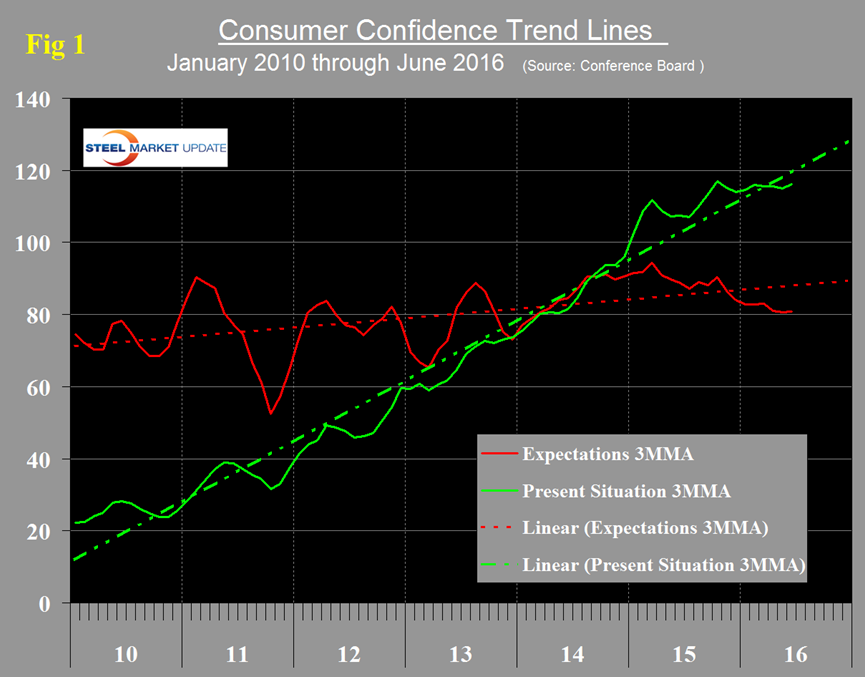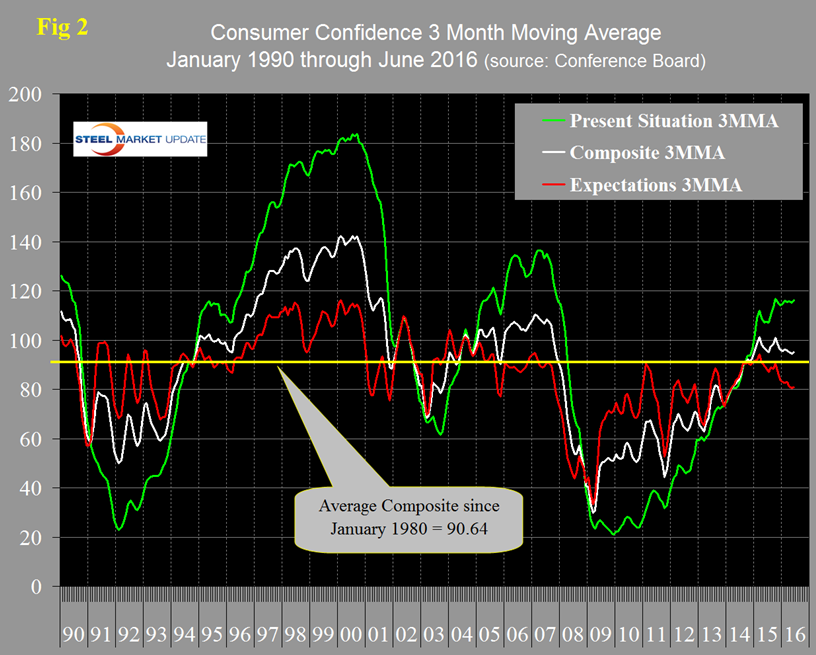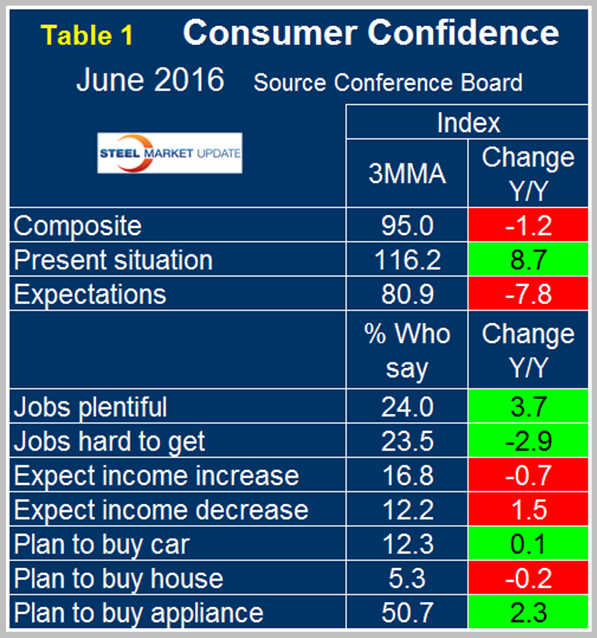Economy

Consumer Confidence in June 2016
Written by Peter Wright
June 27, 2016
Sources for the following article are the Conference Board and SMU analysis. Please see the end of this piece for an explanation of the indicator.
Consumer Confidence jumped from 92.4 in May, the lowest value in 19 months, to 98.0 in June which was the highest value in 8 months. Included below is the official news release from the Conference Board. The three month moving average (3MMA) rose from 94.4 in May to 95.0 in June. We prefer to smooth the data in this way because of monthly volatility which in the case of consumer confidence has been quite extreme since the beginning of last year. The 3MMA of the present situation is now below its six year trend and that of expectations has been below its six year trend for the last nine months (Figure 1).
The historical pattern of the 3MMA of the composite, the view of the present situation and expectations are shown in Figure 2.
The progression of the 3MMA of the composite was positive throughout 2014 but has been trending down since October last year. Since January last year the improvement in the present situation has been more than countered by the deterioration in consumer expectations. Comparing June 2016 with June 2015 (y/y) the 3MMA of the composite was down by 1.2, the present situation was up by 8.7 and expectations were down by 7.8 (Table 1).
Comparing Table 1 with the version that we published in the last three months, the employment situation was unchanged. In all four months the perception of job availability was improving but expectations for wage improvement were deteriorating. Plans to buy homes and appliances improved every month this year until this June result when the house component decreased. Plans to buy a car improved in June after being flat in May.
SMU Comment: Consumer confidence is positively correlated with personal consumption which accounts for about 2/3 of GDP. Ultimately the growth of GDP positively drives steel consumption, therefore, this report is a step in the right direction. Other indicators that we track are generally trending positive as we will show in our key market indicators report later this week.
The official news release from the Conference Board reads as follows and is entirely based on monthly changes. This is a highly regarded indicator which we believe needs to be examined in a longer time context to get the real picture, which is why we only consider three month moving averages and focus our comments on year over year results.
The Conference Board Consumer Confidence Index Improved in June
New York, NY June 28, 2016…The Conference Board Consumer Confidence Index, which had decreased in May, improved in June. The Index now stands at 98.0 (1985=100), up from 92.4 in May. The Present Situation Index increased from 113.2 to 118.3, while the Expectations Index rose from 78.5 to 84.5 in June.
“Consumer confidence rebounded in June, after declining in May,” said Lynn Franco, Director of Economic Indicators at The Conference Board. “Consumers were less negative about current business and labor market conditions, but only moderately more positive, suggesting no deterioration in economic conditions, but no strengthening either. Expectations regarding business and labor market conditions, as well as personal income prospects, improved moderately. Overall, consumers remain cautiously optimistic about economic growth in the short-term.”
Consumers’ appraisal of current conditions improved in June. Those stating business conditions are “good” increased slightly from 26.1 percent to 26.9 percent, while those saying business conditions are “bad” decreased from 21.4 percent to 17.7 percent. Consumers’ assessment of the labor market was mixed. Those claiming jobs are “plentiful” declined from 24.5 percent to 23.4 percent, however those claiming jobs are “hard to get” also decreased from 24.5 percent to 23.3 percent.
Consumers’ optimism regarding the short-term outlook improved in June. Those expecting business conditions to improve over the next six months increased from 15.0 percent to 16.8 percent, while those expecting business conditions to worsen decreased slightly, from 11.7 percent to 11.4 percent.
Consumers’ outlook for the labor market was more favorable than last month. The percentage anticipating more jobs in the months ahead increased from 12.5 percent to 14.2 percent, while those anticipating fewer jobs decreased marginally from 18.2 percent to 17.9 percent. The proportion of consumers expecting their incomes to increase improved from 16.5 percent to 18.2 percent, while the proportion expecting a reduction edged down from 12.6 percent to 11.5 percent.
About The Conference Board
The Conference Board is a global, independent business membership and research association working in the public interest. Our mission is unique: To provide the world’s leading organizations with the practical knowledge they need to improve their performance and better serve society. The monthly Consumer Confidence Survey, based on a probability-design random sample, is conducted for The Conference Board by Nielsen, a leading global provider of information and analytics around what consumers buy and watch. The index is based on 1985 = 100. The composite value of consumer confidence combines the view of the present situation and of expectations for the next six months. The Conference Board is a non-advocacy, not-for-profit entity holding 501 (c) (3) tax-exempt status in the United States. www.conference-board.org

Peter Wright
Read more from Peter WrightLatest in Economy

ISM: Manufacturing expansion loses steam after two months of growth
US manufacturing activity slowed in March after two straight months of expansion, according to supply executives contributing to the Institute for Supply Management (ISM)’s latest report.

Chicago Business Barometer rose to 16-month high in March
The Chicago Business Barometer increased for the third-consecutive month in March. Despite this, it still reflects contracting business conditions, as it has since December 2023.

Durable goods orders rise again in February
Transportation equipment led the increase, rising 1.5% to $98.3 billion.

Consumer confidence falls for fourth consecutive month
People remain concerned about inflation, trade policies, and tariffs.

Housing starts ticked up in February
Single-family starts last month hit a rate of 1.10 million, a month-over-month increase of 11.4%, census data shows.



